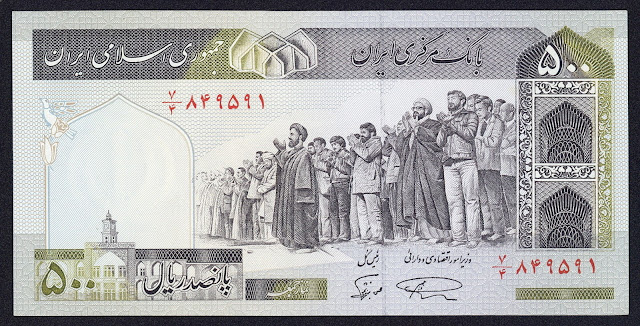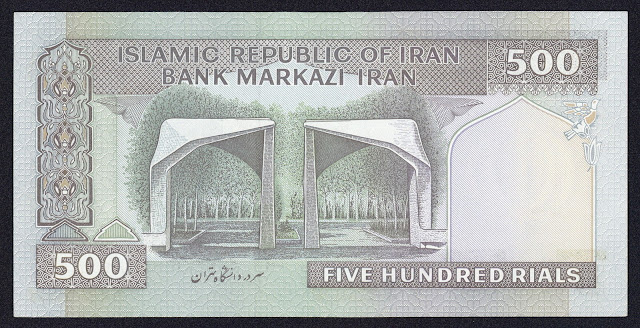Currency of Iran 500 Rials banknote 1982 Friday Prayers
Banknotes of the Islamic Republic of Iran
Revolutionary Series 1981 - 2005
Revolutionary Series 1981 - 2005
Bank Markazi Iran - Central Bank of the Islamic Republic of Iran
Iranian banknotes, Iranian paper money, Iranian bank notes, Iran banknotes, Iran paper money, Iran bank notes.
Obverse: The Friday Prayers, Feyzieh Madressa Seminary at lower left. Gray and olive.
Reverse: Main gate of the Tehran University.
Watermark: Allah emblem on first issues & profile of Mohammad Fahmideh a martyr in the war with Iraq in later issues.
Original Size: 154 x 75 mm.
White security thread with black BANK MARKAZI IRAN in Persian letters repeatedly runs vertically.
Printer: Thomas De La Rue & Company, Limited. (without imprint).
Paper Specifications:
Watermark: The portrait of Imam Khomeini in the left part of the banknote is embedded in the paste of paper. When the Banknote is held up to the light, the image can be seen from both sides.
Security Thread: A 1 mm wide polyester thread, with the microprint of the name of the Central Bank of the Islamic Republic of Iran "Bank Markazi Jomhouri Islami Iran" in Farsi script is embedded in the paper. When viewed under ultra violet light, this thread is seen in blue, yellow and red colors.
Paper: 100% cotton
Invisible Fluorescent Fibers: Fluorescent colored fibers in green, blue, red and yellow embedded in the paste of paper become visible under ultra violet light on the obverse and reverse sides.
Printing Specifications:
Printing Technic: Dry Offset
Serial Number: Letterpress printing of serial number with single color fluorescent ink, changes under ultra violet light to golden color.
See-Through: On the left side of the Watermark is a "See-Through Image". When the Banknote is held up to the light, the partial image of a flower and bird on the front completes perfectly that on the reverse side.
Intaglio Printing: This feature can be easily detected by touch in some parts of the Banknote.
Banknotes of the Islamic Republic of Iran
Revolutionary Series 1981 - 2005
Friday prayer - Jumu'ah
Jumu'ah (Arabic: صلاة الجمعة , ṣalāt al-jum`ah, "Friday prayer"; Persian: نماز جمعه, Namaz Jumah; Turkish: Cuma Namazı, Juma Namazi), is a congregational prayer (ṣalāt) that Muslims hold every Friday, just after noon instead of the Zuhr prayer. Muslims pray ordinarily five times each day according to the sun's sky path regardless of time zones.
In the Quran
It is mentioned in the Quran:
O ye who believe! When the call is proclaimed to prayer on Friday (the Day of Assembly, yawm al-jumu'ah), hasten earnestly to the Remembrance of Allah, and leave off business (and traffic): That is best for you if ye but knew!
And when the Prayer is finished, then may ye disperse through the land, and seek of the Bounty of Allah: and celebrate the Praises of Allah often (and without stint): that ye may prosper.
— Qur'an, sura 62 (Al-Jumua), āyāt 9-10
Format (In Shia Islam)
In Shia Islam, Jumu'ah Salat is wajib-e takhyeri, meaning it is obligatory but optional at the same time; that is if a person prays the Friday prayer, he does not have to pray (al-asr) Noon prayer but you can still pray the two left rakats of asr as Sunnat. Friday prayers consists of 2 Rak'ats like Fajr prayers. The difference between these two prayers is that Namaz-e-Jumuah has two sermons before it. Namaz-e-Jumuah is Wajib Takhyiri, which means that we have an option to offer Jumuah prayers, if its necessary conditions are fulfilled, or to offer Zuhr prayers. Hence, if Namaz-e-Jumuah is offered then it is not necessary to offer Zuhr prayer. If the distance between the two mosques is one Farsakh (5/5 km approximately) or more, the prayers are in order. Friday prayer is Wajib Takhyiri, which means that we have an option to offer Jumuah prayers, if its necessary conditions are met or to offer Zuhr prayers. Hence, if Namaz-e-Jumuah is offered, it is not necessary to offer Zuhr prayer. It is also recommended by Shiite Scholars to attend Jumu'ah as it will become Wajib after the appearance of Imam al-Mahdi and Jesus Christ (Isa).
History
Historically, Shiite clergy discouraged Shiites from attending Friday prayers. According to them, communal Friday prayers with a sermon were wrong and had lapsed (along with other religious practices) until the return of their 12th Imam, Muhammad al-Mahdi. However, among others, Shiite modernist Muhammad ibn Muhammad Mahdi al-Khalisi (1890-1963) demanded that Shiites should more carefully observe Friday prayers in a step to bridge the gap with Sunnis. Later, the practice of communal Friday prayers was developed, and became standard there-afterwards, by Ruhollah Khomeini in Iran and later by Mohammad Mohammad Sadeq al-Sadr in Iraq. They justified the practice under the newly promoted Guardianship of the Islamic Jurists doctrine. When al-Sadr installed Friday prayer imams in Shia-majority areas—a practice not traditional in Iraqi Shiism and considered "revolutionary, if not heretical"—it put him at odds with the Shia religious establishment in Najaf. Under both Khomeini and al-Sadr, political sermons would be heard.
University of Tehran main entrance
The University of Tehran main entrance was designed in 1965 by Korosh Farzami, one of the students of the faculty of Fine Arts of the University and built by Arme Construction Company.
The gates have gradually become an icon of the University's status in Iran's Higher Education system.
Mohammad Hossein Fahmideh
Mohammad Hossein Fahmideh (born 6 May 1967 in Qom – 30 October 1980 in Khorramshahr) is an Iranian war hero and an icon of the Iran–Iraq war.
In September 1980, Iraq initiated the invasion of Iran via air and land, sending five armoured and mechanized divisions across the Shatt al-Arab (Arvand Rud) waterway to invade the oil-rich Khuzestan Province in southern Iran, quickly seizing several towns in the area, and, on November 10, attacked the city of Khorramshahr.
According to his official biography, Fahmideh was a 13-year-old boy from Qom who, at the outbreak of war in 1980, left his home without his parents knowing to go to southern Iran and aid in the defense of Khorramshahr, the front line of the war. In the besieged city of Khorramshahr, he fought side-by-side with older Iranian soldiers. Fahmideh was among the Iranians who engaged in fierce house-to-house battles in which thousands of Iraqis and Iranians were killed. At one point, Iraqi forces pushed the Iranian troops back as they were passing through a very narrow canal. Due to a lack of RPG rockets and the sensitive formation of the Iraqi tanks, Fahmideh, seeing that his older comrades were already dead or wounded, wrapped himself in a grenade belt from a nearby body, pulled the pins out, and jumped underneath an advancing Iraqi tank, killing himself and disabling the tank. This led the Iraqi tank column to believe that the Iranians had mined the area, ceasing their advance. Later, Voice of the Islamic Republic of Iran broadcast a breaking news story describing the incident.
His story inspired many Iranians during the war to risk death to save their young republic and has been heralded by leaders in Iran from Ayatollah Khomeini to President Mohammad Khatami. Ayatollah Khomeini declared Fahmideh an Iranian national hero, and made references to him in several of his speeches:
Our leader is that 13-years-old child who threw himself with his little heart against the enemy. He is worth more than a hundred pens and a hundred tongues.
Fahmideh is buried in Behesht-e Zahra cemetery in Tehran in section 24, row 44, no. 11. A monument to him was erected on the outskirts of Tehran and has become a place of pilgrimage for young Iranians. In the years following Hossein's death, murals have been erected throughout Iran, book bags displaying Hossein were sold to children, and, in 1986, a postage stamp was issued in his memory. Streets, hospitals, schools, and a sports stadium have been named in his honor. The day of his death, October 30, marks the "Student Basij Day" in the official calendar of Iran.
Fahmideh was posthumously awarded the 1st grade Fath Medal on September 27, 1989 after the Iran–Iraq War, becoming its first recipient.

